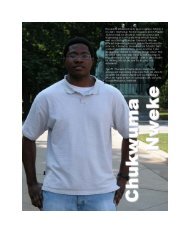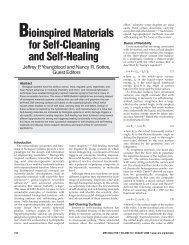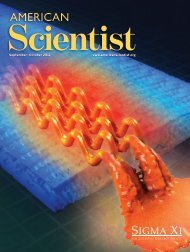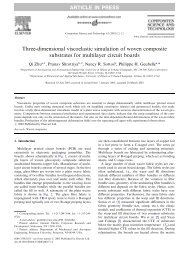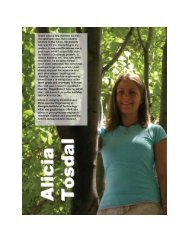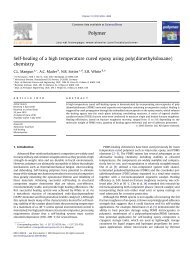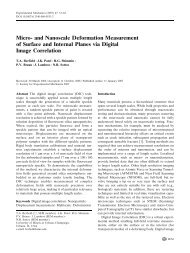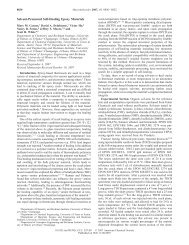Effect of microcapsule size on the performance of self-healing ...
Effect of microcapsule size on the performance of self-healing ...
Effect of microcapsule size on the performance of self-healing ...
You also want an ePaper? Increase the reach of your titles
YUMPU automatically turns print PDFs into web optimized ePapers that Google loves.
J.D. Rule et al. / Polymer 48 (2007) 3520e3529<br />
3527<br />
volumes are small (as with a crack separati<strong>on</strong> <str<strong>on</strong>g>of</str<strong>on</strong>g> <strong>on</strong>ly 3 mm)<br />
<strong>self</strong>-<strong>healing</strong> can be achieved with as little as 1.25 wt% <str<strong>on</strong>g>microcapsule</str<strong>on</strong>g>s<br />
or with <str<strong>on</strong>g>microcapsule</str<strong>on</strong>g>s that are smaller than 30 mm.<br />
By establishing <strong>the</strong> relati<strong>on</strong>ship between <str<strong>on</strong>g>microcapsule</str<strong>on</strong>g> <str<strong>on</strong>g>size</str<strong>on</strong>g>,<br />
<str<strong>on</strong>g>microcapsule</str<strong>on</strong>g>s weight fracti<strong>on</strong>, and crack volume, it is now<br />
possible to rati<strong>on</strong>ally design <strong>self</strong>-<strong>healing</strong> systems that are<br />
tailored to repair specific types <str<strong>on</strong>g>of</str<strong>on</strong>g> damage.<br />
Appendix. Fracture <str<strong>on</strong>g>of</str<strong>on</strong>g> TDCB specimens with localized<br />
incorporati<strong>on</strong> <str<strong>on</strong>g>of</str<strong>on</strong>g> catalyst<br />
Fig. 10. Fracture test results as a functi<strong>on</strong> <str<strong>on</strong>g>of</str<strong>on</strong>g> <strong>healing</strong> agent delivery (calculated<br />
by Eq. (5)) <str<strong>on</strong>g>of</str<strong>on</strong>g> <strong>self</strong>-healed TDCB specimens with a short groove. Various<br />
weight fracti<strong>on</strong>s <str<strong>on</strong>g>of</str<strong>on</strong>g> 251 mm capsules are compared with 15 wt% weight<br />
fracti<strong>on</strong>s <str<strong>on</strong>g>of</str<strong>on</strong>g> various <str<strong>on</strong>g>size</str<strong>on</strong>g> <str<strong>on</strong>g>microcapsule</str<strong>on</strong>g>s. For reference, <strong>the</strong> results with fullycracked<br />
TDCB specimens with 251 mm capsules are included as well.<br />
and given that <strong>the</strong> short-groove specimens require less <strong>healing</strong><br />
agent, <strong>self</strong>-<strong>healing</strong> with smaller <str<strong>on</strong>g>microcapsule</str<strong>on</strong>g>s should be possible<br />
in this case. To c<strong>on</strong>firm this hypo<strong>the</strong>sis, trials were also<br />
performed over a range <str<strong>on</strong>g>of</str<strong>on</strong>g> <str<strong>on</strong>g>microcapsule</str<strong>on</strong>g> <str<strong>on</strong>g>size</str<strong>on</strong>g> while fixing <strong>the</strong><br />
<str<strong>on</strong>g>microcapsule</str<strong>on</strong>g>s weight fracti<strong>on</strong> at 15 wt%. (Fig. 10). The required<br />
<strong>healing</strong> agent delivery for <strong>the</strong> short-groove system is<br />
again c<strong>on</strong>sistent with <strong>the</strong> crack volume. With a crack separati<strong>on</strong><br />
<str<strong>on</strong>g>of</str<strong>on</strong>g> 3 mm, <strong>the</strong> short-groove specimen has a crack volume<br />
<str<strong>on</strong>g>of</str<strong>on</strong>g> about 0.3 mL/cm 2 <str<strong>on</strong>g>of</str<strong>on</strong>g> crack face. Thus, <strong>the</strong> minimum amount<br />
<str<strong>on</strong>g>of</str<strong>on</strong>g> <strong>healing</strong> agent delivery expected to fill this crack is about<br />
0.3 mg/cm 2 , which correlates well with <strong>the</strong> experimental<br />
data (Fig. 10). The maximum amount <str<strong>on</strong>g>of</str<strong>on</strong>g> <strong>self</strong>-<strong>healing</strong> for specimens<br />
with a 29 mm average <str<strong>on</strong>g>microcapsule</str<strong>on</strong>g> diameter was nearly<br />
<strong>the</strong> same as for specimens with larger <str<strong>on</strong>g>microcapsule</str<strong>on</strong>g>s. The excellent<br />
<strong>self</strong>-<strong>healing</strong> achieved with <strong>the</strong>se relatively small <str<strong>on</strong>g>microcapsule</str<strong>on</strong>g>s<br />
is noteworthy c<strong>on</strong>sidering that our previous reports<br />
(all with larger crack volumes) show losses in <strong>self</strong>-<strong>healing</strong> <strong>performance</strong><br />
with <str<strong>on</strong>g>microcapsule</str<strong>on</strong>g>s smaller than 180 mm. These data<br />
c<strong>on</strong>firm that <strong>the</strong> minimum <str<strong>on</strong>g>size</str<strong>on</strong>g> <str<strong>on</strong>g>of</str<strong>on</strong>g> <str<strong>on</strong>g>microcapsule</str<strong>on</strong>g>s needed for<br />
<strong>self</strong>-<strong>healing</strong> depends <strong>on</strong> <strong>the</strong> <str<strong>on</strong>g>size</str<strong>on</strong>g> <str<strong>on</strong>g>of</str<strong>on</strong>g> <strong>the</strong> crack that is being<br />
healed. The data also represent <strong>the</strong> most effective <strong>self</strong>-<strong>healing</strong><br />
with <strong>the</strong> smallest <str<strong>on</strong>g>microcapsule</str<strong>on</strong>g>s reported to date.<br />
5. C<strong>on</strong>clusi<strong>on</strong><br />
The amount <str<strong>on</strong>g>of</str<strong>on</strong>g> <strong>healing</strong> agent delivered in a <strong>self</strong>-<strong>healing</strong> material<br />
is determined by <strong>the</strong> product <str<strong>on</strong>g>of</str<strong>on</strong>g> <strong>the</strong> <str<strong>on</strong>g>microcapsule</str<strong>on</strong>g> weight<br />
fracti<strong>on</strong> and <strong>the</strong> <str<strong>on</strong>g>microcapsule</str<strong>on</strong>g> diameter. Aut<strong>on</strong>omic delivery <str<strong>on</strong>g>of</str<strong>on</strong>g><br />
<strong>healing</strong> agent using <str<strong>on</strong>g>microcapsule</str<strong>on</strong>g>s gives <strong>the</strong> same <strong>healing</strong> <strong>performance</strong><br />
as when a similar amount <str<strong>on</strong>g>of</str<strong>on</strong>g> <strong>healing</strong> agent is delivered<br />
manually. If sufficient <strong>healing</strong> agent is delivered to fill <strong>the</strong><br />
crack volume, <strong>the</strong> <strong>healing</strong> <strong>performance</strong> is maximized. However,<br />
when <strong>the</strong> crack volume exceeds <strong>the</strong> amount <str<strong>on</strong>g>of</str<strong>on</strong>g> available<br />
<strong>healing</strong> agent, less successful <strong>healing</strong> is achieved. When crack<br />
Because Grubbs’ catalyst is available <strong>on</strong>ly in limited quantities<br />
and is expensive, testing methods that minimize catalyst<br />
c<strong>on</strong>sumpti<strong>on</strong> are necessary for repetitive testing <str<strong>on</strong>g>of</str<strong>on</strong>g> <strong>self</strong>-<strong>healing</strong><br />
samples and large sets <str<strong>on</strong>g>of</str<strong>on</strong>g> data. In <strong>the</strong>se fracture tests, catalyst<br />
<strong>on</strong>ly participates in <strong>self</strong>-<strong>healing</strong> up<strong>on</strong> exposure <strong>on</strong> <strong>the</strong> newly<br />
fractured crack plane. Catalyst that is distant from <strong>the</strong> exposed<br />
crack plane remains unused and is wasted in <strong>self</strong>-<strong>healing</strong><br />
evaluati<strong>on</strong>s. To more efficiently use <strong>the</strong> catalyst in our experimental<br />
testing program, a new specimen c<strong>on</strong>figurati<strong>on</strong> was<br />
developed such that <strong>the</strong> catalyst phase is c<strong>on</strong>fined <strong>on</strong>ly to<br />
<strong>the</strong> regi<strong>on</strong>s where <strong>the</strong> damage is expected to occur, i.e. near<br />
<strong>the</strong> centerline groove in a TDCB specimen (Fig. A1). During<br />
sample fabricati<strong>on</strong>, a silic<strong>on</strong>e spacer is placed in <strong>the</strong> regi<strong>on</strong><br />
within <strong>the</strong> mold where <strong>the</strong> catalyst-c<strong>on</strong>taining resin will ultimately<br />
be located. The remainder <str<strong>on</strong>g>of</str<strong>on</strong>g> <strong>the</strong> mold is <strong>the</strong>n filled<br />
with resin to produce a ‘‘blank’’ that does not c<strong>on</strong>tain <strong>the</strong><br />
catalyst. After a prescribed amount <str<strong>on</strong>g>of</str<strong>on</strong>g> cure time, <strong>the</strong> spacer<br />
is removed and this regi<strong>on</strong> is <strong>the</strong>n filled with <strong>the</strong> catalystc<strong>on</strong>taining<br />
resin. The complete specimen is <strong>the</strong>n cured for<br />
24 h at RT followed by 24 h at 35 C.<br />
These ‘‘localized’’ TDCB specimens c<strong>on</strong>tain two slightly<br />
different resin formulati<strong>on</strong>s, <strong>on</strong>e for <strong>the</strong> localized <strong>self</strong>-<strong>healing</strong><br />
regi<strong>on</strong> al<strong>on</strong>g <strong>the</strong> centerline groove and <strong>on</strong>e for <strong>the</strong> blank surrounding<br />
this regi<strong>on</strong>, yet <strong>the</strong>y are intended to act as models<br />
for ‘‘full’’ specimens that have <strong>on</strong>ly <strong>on</strong>e type <str<strong>on</strong>g>of</str<strong>on</strong>g> resin. We<br />
hoped to c<strong>on</strong>firm whe<strong>the</strong>r <strong>the</strong> fracture properties <str<strong>on</strong>g>of</str<strong>on</strong>g> <strong>the</strong>se<br />
two types <str<strong>on</strong>g>of</str<strong>on</strong>g> specimens are approximately equivalent. A systematic<br />
study was undertaken to compare <strong>the</strong> fracture behavior<br />
<str<strong>on</strong>g>of</str<strong>on</strong>g> localized TDCB and full TDCB specimens in order to dem<strong>on</strong>strate<br />
<strong>the</strong>ir equivalence in terms <str<strong>on</strong>g>of</str<strong>on</strong>g> <strong>healing</strong> assessment.<br />
As a baseline for comparis<strong>on</strong>, full TDCB specimens <str<strong>on</strong>g>of</str<strong>on</strong>g><br />
EPON 828/DETA were tested yielding an average fracture<br />
toughness <str<strong>on</strong>g>of</str<strong>on</strong>g> 0.87 MPa m 1/2 . The toughness reported here is<br />
higher than in some <str<strong>on</strong>g>of</str<strong>on</strong>g> our previous studies due to a slightly<br />
higher post-cure temperature used here (35 C vs. 30 C).<br />
Equivalent localized TDCB samples were <strong>the</strong>n prepared with<br />
neat resin in both <strong>the</strong> blank and center regi<strong>on</strong>s. The average<br />
fracture toughness <str<strong>on</strong>g>of</str<strong>on</strong>g> <strong>the</strong>se specimens is <strong>on</strong>ly slightly higher<br />
than with <strong>the</strong> full TDCB geometry (Table A1). When 5 wt%<br />
<str<strong>on</strong>g>of</str<strong>on</strong>g> catalyst-c<strong>on</strong>taining wax microspheres are included in <strong>the</strong><br />
center regi<strong>on</strong>, <strong>the</strong> average fracture toughness is equivalent to<br />
that obtained for <strong>the</strong> full TDCB <str<strong>on</strong>g>of</str<strong>on</strong>g> neat epoxy (Table A1).<br />
When 10 wt% <str<strong>on</strong>g>of</str<strong>on</strong>g> capsules were added to full TDCB<br />
specimens, <strong>the</strong> fracture toughness increases to 0.98 MPa m 1/2<br />
(Table A2). The increase in toughness due to <strong>the</strong> additi<strong>on</strong> <str<strong>on</strong>g>of</str<strong>on</strong>g>





